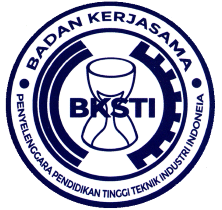Peningkatan Efisiensi Poli Tanin Sebagai Dye Pada Dye Sensitized Solar Cell Menggunakan Crosslinker Glutaraldehyde
DOI:
https://doi.org/10.52759/reactor.v4i1.72Keywords:
Crosslinker, DSSC, Efficiency, Poly-Tannin AcidAbstract
Dye Sensitized Solar Cell (DSSC) is the latest generation of solar cells with dyes as absorbers of photons from sunlight. At this time, the DSSC efficiency obtained is still relatively low so that research on DSSC is still being developed to produce DSSC with higher efficiency. One of the methods used to increase the efficiency of DSSC is polymerization of dyes. Polymerization of dyes aims to increase conjugated double bonds. The more conjugated double bonds, the more photons will be absorbed so that more electrons will flow. In this study, tannins were used as dyes. In the tannin polymerization process, crosslinking agents are used to bind tannin monomers with other tannin monomers. the variable in this study was the volume of the glutaraldehyde crosslinking agent (1.5 mL, 2.5 mL, 3 mL). The results of this study obtained the highest DSSC efficiency of 12.20% at a volume of 2.5 mL of crosslinking agent.
References
I. Kholiq, “Analisis Pemanfaatan Sumber Daya Energi Alternatif Sebagai Energi Terbarukan untuk Mendukung Subt itusi BBM,” Jurnal Iptek, vol. 19, no. 2, pp. 75–91, 2015.
R. G. Lina and H. Hardeli, “Pengaruh KOH Sebagai Inisiator Pada Polimerisasi Tanin Terhadap Efisiensi Sel Surya DSSC,” Periodic, vol. 11, no. 1, pp. 40–44, 2022.
R. Andari, “Sintesis dan Karakterisasi Dye Sensitized Solar Cells (DSSC) dengan Sensitizer Antosianin dari Bunga Rosella,” JIIF (Jurnal Ilmu dan Inovasi Fisika), vol. 1, no. 2, pp. 140–150, 2017.
R. Damayant i, Hardeli, and H. Sanjaya, “Preparasi Dye Sensitized Solar Cell (DSSC) Menggunakan Ekstrak Antosianin Ubi Jalar Ungu (Ipomea batatas L.),” Jurnal Sains dan Teknologi, vol. 6, no. 2, 2014.
D. L. Pangestuti, G. Gunawan, and A. Haris, “Pembuatan Dye Sensit ized Solar Cell (DSSC) dengan Sensitizer Antosianin dari Buah Buni (Ant idesma bunius L),” Jurnal Kimia Sains dan Aplikasi, vol. 11, no. 3, 2008.
R. Sri Iriant y and S. R. Yenti, “Pengaruh Perbandingan Pelarut Etanol-Air Terhadap Kadar Tanin Pada Sokletasi Daun Gambir (Uncaria gambir Roxb),” Sagu, vol. 13, no. 1, 2014.
T. S. Fangidae, T. M. P. B. Bage, A. A. Anggrowati, and Y. Sudaryanto, “Study of Malachite Green Adsorption using Tannin-Based Adsorbent (TBA) from Mangrove Bark (Rhizophora mucronata),” In Seminar Nasional Teknik Kimia Kejuangan, p. 9, 2020.
Y. C. Danarto, S. Ajie Prihananto, and Z. Anjas Pamungkas, “Pemanfaatan Tanin dari Kulit Kayu Bakau sebagai Pengganti Gugus Fenol pada Resin Fenol Formaldehid,” Prosiding Seminar Nasional Teknik Kimia “Kejuangan” 2011, 2011.
M. S. Alhumaimess et al., “Recyclable Glutaraldehyde Cross-linked Polymeric Tannin to Sequester Hexavalent Uranium from Aqueous Solution,” J Mol Liq, vol. 281, 2019.
R. T. Ako et al., “Evaluation of Surface Energy State Distribution and Bulk Defect Concentration in DSSC Photoanodes Based on Sn, Fe, and Cu Doped TiO 2 ,” Appl Surf Sci, vol. 351, 2015.
Nuryetti, H. Hermansyah, and M. Nasikin, “Bionanokomposit: Peluang Polimer Alami Sebagai Material Baru Semikonduktor,” Riset Industri, vol. VI, no. I, 2012.
T. Varila, H. Romar, T. Luukkonen, T. Hilli, and U. Lassi, “Characterizat ion of Lignin Enforced Tannin/Furanic Foams,” Heliyon, vol. 6, no. 1, 2020.
R. G. Lina and H. Hardeli, “Pengaruh KOH Sebagai Inisiator Pada Polimerisasi Tanin Terhadap Efisiensi Sel Surya DSSC,” Periodic, vol. 11, no. 1, 2022.
S. Chadijah, D. Dahlan, and H. Harmadi, “Pembuatan Counter Electrode Karbon Untuk Aplikasi Elektroda Dye-Sensitized Solar Cell (DSSC),” Jurnal Ilmu Fisika | Universitas Andalas, vol. 8, no. 2, 2017.
K. Z. Taqwa, “Studi Eksperimental Pengaruh Intensitas Cahaya Terhadap Performa DSSC (Dye Sensitized Solar Cell) Dengan Ekstrak Buah dan Sayur Sebagai Dye Sensit izer,” (Doctoral Dissertation, Institut Technology Sepuluh Nopember), 2015.
H. Sanjaya, “Degradasi Metil Violet Menggunakan Katalis ZnO-TiO 2 Secara Fotosonolisis,” Eksakta: Berkala Ilmiah Bidang MIPA (E-ISSN: 25497464), vol. 19, no. 1, pp. 91–99, 2018.
R. N. Maurani, D. Purnamasari, and R. Zainul, “Preparat ion of TiO 2 Thin Layer on Ceramics Using Dip Coating Method for Degradation Humic Acid,” in Journal of Physics: Conference Series, 2020.
F. N. Agdisti, L. Yunita, R. Luli, P. I. Novita, and Hardeli, “Peningkatan Performansi Dye Sensit ized Solar Cell (DSSC) dengan Ekstrak Kulit Jengkol sebagai Zat Warna Melalui Elektrodeposisi Zn pada TiO2,” Paper Knowledge. Toward a Media History of Documents, vol. 3, no. 21, 2019.
R. Habibah, “Penentuan Berat Molekul dan Derajat Polimerisasi Α – Selulosa Yang Berasal dari AlangAlang (Imperata Cylindrica) dengan Metode Viskositas,” Saintia Kimia, vol.1, 2013.
Wahyu. Hariyanto, Hariyanto & Tofa, Mus & Djafar, Zuryat i & Piarah, “Mathemat ical Modeling in Combining Photovoltaic and Thermoelectric Generator using a Spectrum Splitter,” EPI International Journal of Engineering, vol. 2, pp. 74–79, 2019.




